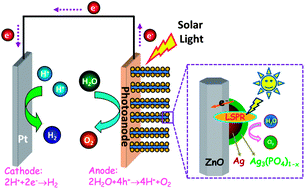We report the new design of a high-activity model for photocatalytic nanosystem comprising an Ag core covered with an approximately 2 nm thick nanoshell of Ag3(PO4)1–x (Ag@Ag3(PO4)1–x) on the ZnO NRs that are visible-light-sensitive photofunctional electrodes with strong photooxidative capabilities to evolve O2 from water. The maximum photoconversion efficiency that could be successfully achieved was 2%, with a significant photocurrent of 3.1 mA cm−2. Furthermore, in addition to achieving a maximum IPCE value of 90%, it should be noted that the IPCE of Ag@Ag3(PO4)1−x photosensitized ZnO photoanodes at the monochromatic wavelength of 400 nm is up to 60%. Our photoelectrochemical performances are comparable to those of many oxide-based photoanodes in recent reports. The improvement in photoactivity of PEC water-splitting may be attributed to the enhanced near-field amplitudes resulting from localized surface plasmon resonance (LSPR) of Ag–core and absorption edge of the Ag3(PO4)1−x nanoshell, which increase the rate of formation of electron–hole pairs at the nearby surface of Ag3(PO4)1−x nanoshell and ZnO nanorod, thus enlarging the amount of photogenerated charge contributing to photocatalysis. The capability of developing highly photoactive Ag@Ag3(PO4)1−x-photosensitized ZnO photoanodes opens up new opportunities in various photocatalytic areas, particularly solar-hydrogen fields.

You have access to this article
 Please wait while we load your content...
Something went wrong. Try again?
Please wait while we load your content...
Something went wrong. Try again?


 Please wait while we load your content...
Please wait while we load your content...